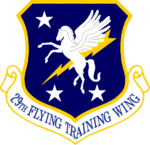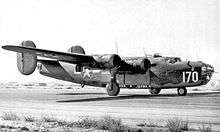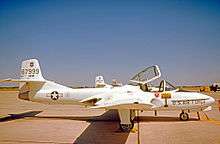29th Flying Training Wing
29th Flying Training Wing
 | |
|---|---|
|
T-38 Talon as flown by the 29th Flying Training Wing | |
| Active | 1939–1944; 1944-1946; 1972–1977 |
| Country |
|
| Branch |
|
| Role | Flying training |
| Motto(s) | Power for Peace |
| Engagements | Pacific Theater of Operations |
| Decorations | Air Force Outstanding Unit Award |
| Insignia | |
| 29th Flying Training Wing emblem (Approved 12 March 1973)[1] |
 |
| 29th Bombardment Group emblem (Approved 14 October 1940)[2] |
 |
| World War II tail code | Square O |
The 29th Flying Training Wing is an inactive United States Air Force unit last based at Craig AFB, Alabama. It was inactivated when Craig AFB was closed as a budget reduction action after the Vietnam War.
The unit's origins begin with its United States Army Air Forces World War II predecessor, the 29th Bombardment Group (29th BG). It originally conducted anti-submarine warfare over the Caribbean during the early years of the war as part of Third Air Force. Later, the 29th BG was a Replacement Training Unit (RTU) of the Army Air Forces Training Command. In 1944, the group was reequipped with Boeing B-29 Superfortresses and was engaged in combat as part of Twentieth Air Force. The 29th Bomb Group's aircraft engaged in very heavy bombardment operations against Japan.
History
World War II

Constituted as the 29th Bombardment Group (Heavy) on 22 December 1939. Activated on 1 February 1940 at Langley AAF, Virginia. Equipped with Boeing B-17 Flying Fortresses and Douglas B-18 Bolos, the group trained and took part in aerial reviews as part of the GHQ Air Force.
After the attack on Pearl Harbor, the 29th was reassigned to Third Air Force and flew antisubmarine patrol missions in the Caribbean area, December 1941 – June 1942 from MacDill AAF, Florida.
After the antisubmarine mission was turned over to the Navy and Coast Guard, the 29th was reequipped with Consolidated B-24 Liberator bombers and was reassigned to Gowen Field, Idaho, where it functioned as an operational training (OTU) and later as a replacement training unit (RTU). The group was inactivated on 1 April 1944 and replaced by an AAF Base Unit.

The group was immediately redesignated as the 29th Bombardment Group (Very Heavy) and was reactivated the same day. Equipped with Boeing B-29 Superfortresses, the unit was remanned and reassigned to Pratt Army Air Field, Kansas. At Pratt, the unit prepared for overseas duty and was deployed to the Southwest Pacific, being assigned to North Field, Guam during December 1944/January 1945. On Guam, the 29th was assigned to the Twentieth Air Force, 314th Bombardment Wing. Its B-29 tail code was "Square O".
The 29th flew its first mission against Japan with an attack on Tokyo on 25 February 1945. It conducted a number of missions against strategic targets in Japan, operating in daylight and at high altitude to bomb factories, refineries, and other objectives. Beginning in March 1945, the group carried out incendiary raids on area targets, flying at night and at low altitude to complete the assignments.
S/Sgt Henry E Erwin was awarded the Medal of Honor for action that saved his B-29 during a mission over Koriyama, Japan, on 12 April 1945. When a phosphorus smoke bomb exploded in the launching chute and shot back into the plane, Sgt Erwin picked up the burning bomb, carried it to a window, and threw it out.
During the Allied assault on Okinawa, the 29th Bomb Group bombed airfields from which the enemy was sending out suicide planes against the invasion force. Received a Distinguished Unit Citation for an attack on an airfield at Omura, Japan, on 31 March 1945. Received a second DUC for strikes on the industrial area of Shizuoka, the Mitsubishi aircraft plant at Tamashima, and the Chigusa arsenal at Nagoya,
in June 1945. After the war, dropped food and supplies to Allied prisoners and participated in several show-of-force missions over Japan. Inactivated on Guam on 20 May 1946.
Pilot Training


The 29th Flying Training Wing replaced, and absorbed resources of, the 3615th Flying Training Wing on 1 July 1972. at Craig Air Force Base, Alabama. The 29th FTW conducted graduate pilot training and operated Craig AFB, Ala, facilities. In 1974, Craig AFB was selected as one of two UPT bases to be closed in a post-Vietnam economic move. In 1977, Air Training Command closed Craig Air Force Base along with Webb Air Force Base in Texas. Craig's 29th Flying Training Wing was inactivated on 30 September 1977 and the field was placed on caretaker status the next day.
Lineage
- 29th Bombardment Group
- Constituted as the 29th Bombardment Group (Heavy) on 22 December 1939
- Activated on 1 February 1940
- Inactivated on 1 April 1944
- Redesignated 29th Bombardment Group, Very Heavy and activated on 1 April 1944
- Inactivated on 20 May 1946[2]
- Consolidated with the 29th Flying Training Wing as the 29th Flying Training Wing on 31 January 1984[3]
- 29th Flying Training Wing
- Established as the 29th Flying Training Wing on 22 March 1972
- Activated on 1 July 1972
- Inactivated on 30 September 1977[1]
- Consolidated with the 29th Bombardment Group on 31 January 1984 (remained inactive)[3]
Assignments
- General Headquarters Air Force, 1 February 1940
- Southeast Air District, 21 May 1940
- 3d Bombardment Wing, c. October 1940[4]
- II Bomber Command, 25 June 1942 – 1 April 1944
- II Bomber Command, 1 April 1944 (attached to 17th Bombardment Operational Training Wing after c. 15 April 1944)[5]
- 314th Bombardment Wing, 9 November 1944 – 20 May 1946 (attached to 17th Bombardment Operational Training Wing until 17 December 1944)[5][6]
- Air Training Command, 1 July 1972 – 30 September 1977[1]
Components
- 6th Bombardment Squadron 1 February 1940 – 1 April 1944, 1 April 1944 – 20 May 1946[7]
- 43d Bombardment Squadron (later 43d Flying Training Squadron) 1 Feb 1940 – 1 Apr 1944; 1 Apr 1944-20 May 1946,[8] 1972–1977[1]
- 52d Bombardment Squadron (later 52d Flying Training Squadron) 1 Feb 1940 – 1 Apr 1944; 1 Apr 1944-20 May 1946,[9] 1972–1977[1]
- 21st Reconnaissance Squadron (later 411th Bombardment Squadron) Attached 5 September 1941, assigned 25 February 1942 – 1 April 1944; 1 April - 10 May 1944[10]
Stations
- Langley Field, Virginia, 1 February 1940
- MacDill Field, Florida 21 May 1940
- Gowen Field, Idaho 25 June 1942 – 1 April 1944
- Pratt Army Air Field, Kansas 1 April – 7 December 1944
- North Field, Guam, Northern Mariana Islands, 17 January 1945 – 20 May 1946[2]
- Craig Air Force Base, Alabama, 1 July 1972 – 30 September 1977[1]
Aircraft
- Douglas B-18 Bolo, 1940-1942
- Boeing B-17C Flying Fortress, 1940-1943
- Consolidated B-24 Liberator, 1943-1944
- Boeing B-29 Superfortress, 1944-1946
- Cessna T-37 Tweet, 1972–1977
- Northrop T-38 Talon, 1972–1977
- Cessna T-41 Mescalero, 1972–1973
See also
- B-17 Flying Fortress units of the United States Army Air Forces
- B-24 Liberator units of the United States Army Air Forces
- List of B-29 Superfortress operators
References
Notes
- 1 2 3 4 5 6 Ravenstein, p. 54
- 1 2 3 Maurer, Combat Units, pp. 81-82
- 1 2 Department of the Air Force/MPM Letter 539q, 31 January 1984, Subject: Consolidation of Units
- ↑ Maurer, Combat Units, pp. 414-415
- 1 2 "Factsheet 17 Air Division". Air Force Historical Research Agency. 4 October 2007. Archived from the original on 30 October 2012. Retrieved 9 April 2014.
- ↑ "Factsheet 314 Air Division". Air Force Historical Research Agency. 12 October 2007. Archived from the original on 29 September 2012. Retrieved 3 March 2014.
- ↑ Maurer, Combat Squadrons, p. 38
- ↑ Maurer, Combat Squadrons, p. 196
- ↑ Maurer, Combat Squadrons, p. 219
- ↑ Maurer, Combat Squadrons, pp. 502-503
Bibliography
![]() This article incorporates public domain material from the Air Force Historical Research Agency website http://www.afhra.af.mil/.
This article incorporates public domain material from the Air Force Historical Research Agency website http://www.afhra.af.mil/.
- Maurer, Maurer, ed. (1983) [1961]. Air Force Combat Units of World War II (PDF) (reprint ed.). Washington, DC: Office of Air Force History. ISBN 0-912799-02-1. LCCN 61060979.
- Maurer, Maurer, ed. (1982) [1969]. Combat Squadrons of the Air Force, World War II (PDF) (reprint ed.). Washington, DC: Office of Air Force History. ISBN 0-405-12194-6. LCCN 70605402. OCLC 72556.
- Ravenstein, Charles A. (1984). Air Force Combat Wings, Lineage & Honors Histories 1947-1977 (PDF). Washington, DC: Office of Air Force History. ISBN 0-912799-12-9.


.png)
.svg.png)
